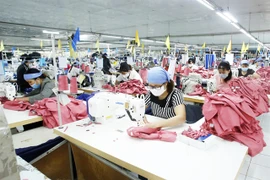Hanoi (VNS/VNA) - Vietnam's leather and footwearindustry was on course for a strong recovery as more international fashionbrands were valuing the country as an important part of the global supplychain, according to the Vietnam Leather, Footwear and Handbag Association(LEFASO).
Phan Thi Thanh Xuan, Vice President of LEFASO, said manyVietnamese leather and footwear producers had secured enough orders to keepproduction running until the end of the year. This was due in no small part tothe country's successful effort to contain and fight off the COVID-19 pandemic.
In addition, the country has become a popular destination forforeign investment after signing a number of historic trade deals such as theComprehensive and Progressive Agreement for Trans-Pacific Partnership (CPTPP)and the EU-Vietnam Free Trade Agreement (EVFTA). A recent survey by LEFASOshowed that more than 40 percent of international buyers said they were eitherplacing additional orders or planning to do so in the near future.
Domestic firms, in light of the disruption caused by thepandemic and drastic falls in demand in traditional export markets such as theEU (-27 percent) and the US (-21 percent) compared with the previous year, wereseeking new buyers and pushing for cost-cutting restructuring measures.
As a result, Vietnam's localisation ratio among leather andfootwear producers has seen an improvement to average 30-40 percent, with keyexport products including sportswear and footwear up to over 50 percent.
"As we enter the last quarter of the year, there havebeen many positive signs of a strong recovery for leather and footwearmakers," Xuan said.
Statistics from the General Department of Vietnam Customs andthe Ministry of Industry and Trade appeared to support the idea with exportvolume showing a strong recovery in September, posting a 4.5 percent increasefrom August and only a slight 0.4 percent decrease from the same period lastyear despite the ongoing pandemic.
Leather and footwear producers have also been recruiting additionalworkers as production starts kicking back into high gear.
This rosy picture, however, had not been seen by everyone inleather and footwear. 2021 remained unpredictable even for those who were doingwell at the moment, said Xuan.
Free trade agreements and preferential policies, while givingsome advantages for Vietnamese products, could not decide the outcome of thecompetition.
Vietnam's leather and footwear industry was still strugglingto deal with a host of problems, including its reliance on imports of rawmaterials and tightened labour regulations.
Xuan said firms must start investing in new technology,improving the labour force and building contingency plans in order to stayquick on their feet and ready to respond and adapt to changes in the businessenvironment.
Vietnam has over 1,700 leather and footwear makers with atotal production capacity of 1.1 billion pairs of footwear, and 400 millionbags and backpacks a year.
Footwear exports alone were estimated at 12.8 billion USD inthe first nine months of the year, an 8.8 percent decrease compared to the sameperiod last year, and only half of the industry's target of 24 billion USD set for2020./.






























